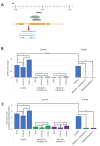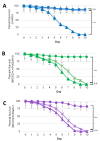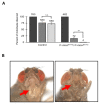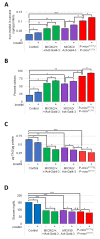Inositol in Disease and Development: Roles of Catabolism via myo-Inositol Oxygenase in Drosophila melanogaster
- PMID: 36835596
- PMCID: PMC9967586
- DOI: 10.3390/ijms24044185
Inositol in Disease and Development: Roles of Catabolism via myo-Inositol Oxygenase in Drosophila melanogaster
Abstract
Inositol depletion has been associated with diabetes and related complications. Increased inositol catabolism, via myo-inositol oxygenase (MIOX), has been implicated in decreased renal function. This study demonstrates that the fruit fly Drosophila melanogaster catabolizes myo-inositol via MIOX. The levels of mRNA encoding MIOX and MIOX specific activity are increased when fruit flies are grown on a diet with inositol as the sole sugar. Inositol as the sole dietary sugar can support D. melanogaster survival, indicating that there is sufficient catabolism for basic energy requirements, allowing for adaptation to various environments. The elimination of MIOX activity, via a piggyBac WH-element inserted into the MIOX gene, results in developmental defects including pupal lethality and pharate flies without proboscises. In contrast, RNAi strains with reduced levels of mRNA encoding MIOX and reduced MIOX specific activity develop to become phenotypically wild-type-appearing adult flies. myo-Inositol levels in larval tissues are highest in the strain with this most extreme loss of myo-inositol catabolism. Larval tissues from the RNAi strains have inositol levels higher than wild-type larval tissues but lower levels than the piggyBac WH-element insertion strain. myo-Inositol supplementation of the diet further increases the myo-inositol levels in the larval tissues of all the strains, without any noticeable effects on development. Obesity and blood (hemolymph) glucose, two hallmarks of diabetes, were reduced in the RNAi strains and further reduced in the piggyBac WH-element insertion strain. Collectively, these data suggest that moderately increased myo-inositol levels do not cause developmental defects and directly correspond to reduced larval obesity and blood (hemolymph) glucose.
Keywords: Drosophila; developmental defect; diabetes; head; inositol; metabolism; obesity; oxygenase; proboscis.
Conflict of interest statement
The authors declare no conflict of interest.
Figures




Similar articles
-
Study on the osmotic response and function of myo-inositol oxygenase in euryhaline fish nile tilapia (Oreochromis niloticus).Am J Physiol Cell Physiol. 2024 Apr 1;326(4):C1054-C1066. doi: 10.1152/ajpcell.00513.2023. Epub 2024 Feb 12. Am J Physiol Cell Physiol. 2024. PMID: 38344798
-
Transcriptional and Translational Modulation of myo-Inositol Oxygenase (Miox) by Fatty Acids: IMPLICATIONS IN RENAL TUBULAR INJURY INDUCED IN OBESITY AND DIABETES.J Biol Chem. 2016 Jan 15;291(3):1348-67. doi: 10.1074/jbc.M115.698191. Epub 2015 Nov 17. J Biol Chem. 2016. PMID: 26578517 Free PMC article.
-
Renal depletion of myo-inositol is associated with its increased degradation in animal models of metabolic disease.Am J Physiol Renal Physiol. 2015 Nov 1;309(9):F755-63. doi: 10.1152/ajprenal.00164.2015. Epub 2015 Aug 26. Am J Physiol Renal Physiol. 2015. PMID: 26311112
-
Potential of engineering the myo-inositol oxidation pathway to increase stress resilience in plants.Mol Biol Rep. 2022 Aug;49(8):8025-8035. doi: 10.1007/s11033-022-07333-0. Epub 2022 Mar 16. Mol Biol Rep. 2022. PMID: 35294703 Review.
-
Potential role and therapeutic interests of myo-inositol in metabolic diseases.Biochimie. 2013 Oct;95(10):1811-27. doi: 10.1016/j.biochi.2013.05.011. Epub 2013 Jun 10. Biochimie. 2013. PMID: 23764390 Review.
Cited by
-
Role of Drosophila in Human Disease Research 3.0.Int J Mol Sci. 2023 Dec 25;25(1):292. doi: 10.3390/ijms25010292. Int J Mol Sci. 2023. PMID: 38203464 Free PMC article.
-
Low-Frequency Ultrasound Assisted in Improvement in Cell Development and Production of Parasporal Crystals from Bacillus thuringiensis HD1.Insects. 2025 May 9;16(5):507. doi: 10.3390/insects16050507. Insects. 2025. PMID: 40429220 Free PMC article.
-
Novel Genetic Variants Associated with Diabetic Neuropathy Risk in Type 2 Diabetes: A Whole-Exome Sequencing Approach.Int J Mol Sci. 2025 Jun 28;26(13):6239. doi: 10.3390/ijms26136239. Int J Mol Sci. 2025. PMID: 40650017 Free PMC article.
References
-
- D’Anna R., Corrado F., Loddo S., Gullo G., Giunta L., Di Benedetto A. Myoinositol plus α-lactalbumin supplementation, insulin resistance and birth outcomes in women with gestational diabetes mellitus: A randomized, controlled study. Sci. Rep. 2021;11:8866. doi: 10.1038/s41598-021-88329-x. - DOI - PMC - PubMed
-
- Kiani A.K., Paolacci S., Calogero A.E., Cannarella R., Di Renzo G.C., Gerli S., Della Morte C., Busetto G.M., De Berardinis E., Del Giudice F., et al. From Myo-inositol to D-chiro-inositol molecular pathways. Eur. Rev. Med. Pharmacol. Sci. 2021;25:2390–2402. doi: 10.26355/EURREV_202103_25279. - DOI - PubMed
MeSH terms
Substances
Grants and funding
LinkOut - more resources
Full Text Sources
Molecular Biology Databases

